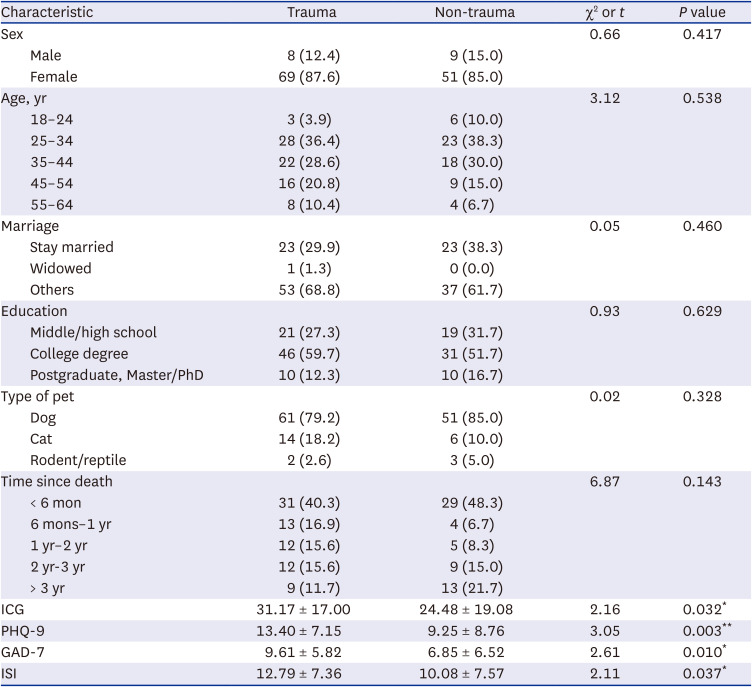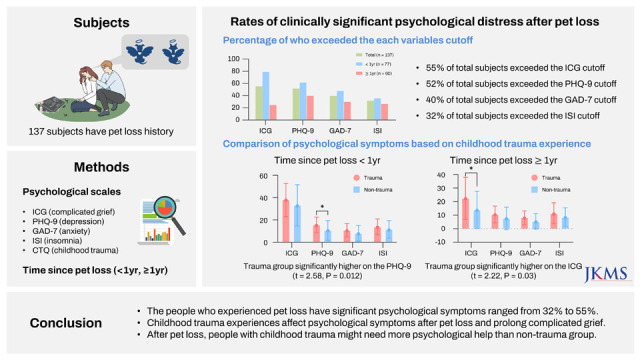1. Ji I, Kim H, Kim W, Seo G. Development Strategies for the Companion Animal Industry. Naju, Korea: Korea Rural Economic Institute;2017. p. 11–13.
2. Jung MJ, Ahn HN. Adult’s pet euthanasia experience and complicated grief: an exploratory study on the risk factors. Korean J Couns. 2020; 21(2):269–289.
3. Clements PT, Benasutti KM, Carmone A. Support for bereaved owners of pets. Perspect Psychiatr Care. 2003; 39(2):49–54. PMID:
12894598.

4. Chur-Hansen A. Grief and bereavement issues and the loss of a companion animal: people living with a companion animal, owners of livestock, and animal support workers. Clin Psychol. 2010; 14(1):14–21.

5. Sable P. The pet connection: an attachment perspective. Clin Soc Work J. 2013; 41(1):93–99.

6. Barnard-Nguyen S, Breit M, Anderson KA, Nielsen J. Pet loss and grief: identifying at-risk pet owners during the euthanasia process. Anthrozoos. 2016; 29(3):421–430.

7. American Psychiatric Association. Diagnostic and Statistical Manual of Mental Disorders: DSM-5. Washington, D.C., USA: American Psychiatric Association;2013.
8. Packman W, Field NP, Carmack BJ, Ronen R. Continuing bonds and psychosocial adjustment in pet loss. J Loss Trauma. 2011; 16(4):341–357.
9. Sharkin BS, Knox D. Pet loss: issues and implications for the psychologist. Prof Psychol Res Pr. 2003; 34(4):414–421.

10. Hunt M, Padilla Y. Development of the pet bereavement questionnaire. Anthrozoos. 2006; 19(4):308–324.

11. Bonanno GA, Field NP. Examining the delayed grief hypothesis across 5 years of bereavement. Am Behav Sci. 2001; 44(5):798–816.

12. Turner WG. Bereavement counseling: using a social work model for pet loss. J Fam Soc Work. 2003; 7(1):69–81.

13. Ross CB. Pet Loss and Human Emotion: A Guide to Recovery. Florence, KY, USA: Taylor & Francis;2013.
14. Field NP, Orsini L, Gavish R, Packman W. Role of attachment in response to pet loss. Death Stud. 2009; 33(4):334–355. PMID:
19368063.

15. Archer J, Winchester G. Bereavement following death of a pet. Br J Psychol. 1994; 85(Pt 2):259–271. PMID:
8032709.

16. Monroe SM, Simons AD. Diathesis-stress theories in the context of life stress research: implications for the depressive disorders. Psychol Bull. 1991; 110(3):406–425. PMID:
1758917.

17. Glaser JP, van Os J, Portegijs PJ, Myin-Germeys I. Childhood trauma and emotional reactivity to daily life stress in adult frequent attenders of general practitioners. J Psychosom Res. 2006; 61(2):229–236. PMID:
16880026.

18. McLaughlin KA, Conron KJ, Koenen KC, Gilman SE. Childhood adversity, adult stressful life events, and risk of past-year psychiatric disorder: a test of the stress sensitization hypothesis in a population-based sample of adults. Psychol Med. 2010; 40(10):1647–1658. PMID:
20018126.

19. Vanderwerker LC, Jacobs SC, Parkes CM, Prigerson HG. An exploration of associations between separation anxiety in childhood and complicated grief in later life. J Nerv Ment Dis. 2006; 194(2):121–123. PMID:
16477190.

20. Chen MA, Lewis MR, Chirinos DA, Murdock KW, Fagundes C. Differential psychological reactions to grief: the role of childhood adversity for depression symptoms among bereaved and non-bereaved adults. Death Stud. 2020; 44(12):778–786. PMID:
31094661.

21. Bernstein D, Fink L. Childhood Trauma Questionnaire: A Retrospective Self-Report: Manual. San Antonio, TX, USA: Psychological Corporation;1998.
22. Yu J, Park J, Park D, Ryu S, Ha J. Validation of the Korean Childhood Trauma Questionnaire: the practical use in counselling and therapeutic intervention. Korean J Health Psychol. 2009; 14(3):563–578.

23. Prigerson HG, Maciejewski PK, Reynolds CF 3rd, Bierhals AJ, Newsom JT, Fasiczka A, et al. Inventory of Complicated Grief: a scale to measure maladaptive symptoms of loss. Psychiatry Res. 1995; 59(1-2):65–79. PMID:
8771222.

24. Han DH, Lee JJ, Moon DS, Cha MJ, Kim MA, Min S, et al. Korean version of Inventory of Complicated Grief scale: psychometric properties in Korean adolescents. J Korean Med Sci. 2016; 31(1):114–119. PMID:
26770046.

25. Spitzer RL, Kroenke K, Williams JB. Validation and utility of a self-report version of PRIME-MD: the PHQ primary care study. Primary Care Evaluation of Mental Disorders. Patient Health Questionnaire. JAMA. 1999; 282(18):1737–1744. PMID:
10568646.

26. Han C, Jo SA, Kwak JH, Pae CU, Steffens D, Jo I, et al. Validation of the Patient Health Questionnaire-9 Korean version in the elderly population: the Ansan Geriatric study. Compr Psychiatry. 2008; 49(2):218–223. PMID:
18243897.

27. Choi HS, Choi JH, Park KH, Joo KJ, Ga H, Ko HJ, et al. Standardization of the Korean version of Patient Health Questionnaire-9 as a screening instrument for major depressive disorder. J Korean Acad Fam Med. 2007; 28(2):114–119.
28. Manea L, Gilbody S, McMillan D. Optimal cut-off score for diagnosing depression with the Patient Health Questionnaire (PHQ-9): a meta-analysis. CMAJ. 2012; 184(3):E191–E196. PMID:
22184363.
29. Spitzer RL, Kroenke K, Williams JB, Löwe B. A brief measure for assessing generalized anxiety disorder: the GAD-7. Arch Intern Med. 2006; 166(10):1092–1097. PMID:
16717171.

30. Kroenke K, Spitzer RL, Williams JB, Monahan PO, Löwe B. Anxiety disorders in primary care: prevalence, impairment, comorbidity, and detection. Ann Intern Med. 2007; 146(5):317–325. PMID:
17339617.
31. Lee B, Kim YE. The psychometric properties of the Generalized Anxiety Disorder scale (GAD-7) among Korean university students. Psychiatry Clin Psychopharmacol. 2019; 29(4):864–871.

32. Löwe B, Decker O, Müller S, Brähler E, Schellberg D, Herzog W, et al. Validation and standardization of the Generalized Anxiety Disorder Screener (GAD-7) in the general population. Med Care. 2008; 46(3):266–274. PMID:
18388841.

33. Morin CM, Belleville G, Bélanger L, Ivers H. The Insomnia Severity Index: psychometric indicators to detect insomnia cases and evaluate treatment response. Sleep (Basel). 2011; 34(5):601–608.

34. Cho YW, Song ML, Morin CM. Validation of a Korean version of the Insomnia Severity Index. J Clin Neurol. 2014; 10(3):210–215. PMID:
25045373.

35. Hammen C, Henry R, Daley SE. Depression and sensitization to stressors among young women as a function of childhood adversity. J Consult Clin Psychol. 2000; 68(5):782–787. PMID:
11068964.
36. Riggs SA, Kaminski P. Childhood emotional abuse, adult attachment, and depression as predictors of relational adjustment and psychological aggression. J Aggress Maltreat Trauma. 2010; 19(1):75–104.

37. Kwako LE, Noll JG, Putnam FW, Trickett PK. Childhood sexual abuse and attachment: an intergenerational perspective. Clin Child Psychol Psychiatry. 2010; 15(3):407–422. PMID:
20603427.
38. Piccinelli M, Wilkinson G. Gender differences in depression. Critical review. Br J Psychiatry. 2000; 177(6):486–492. PMID:
11102321.
39. McLean CP, Asnaani A, Litz BT, Hofmann SG. Gender differences in anxiety disorders: prevalence, course of illness, comorbidity and burden of illness. J Psychiatr Res. 2011; 45(8):1027–1035. PMID:
21439576.

40. Kersting A, Brähler E, Glaesmer H, Wagner B. Prevalence of complicated grief in a representative population-based sample. J Affect Disord. 2011; 131(1-3):339–343. PMID:
21216470.









 PDF
PDF Citation
Citation Print
Print




 XML Download
XML Download